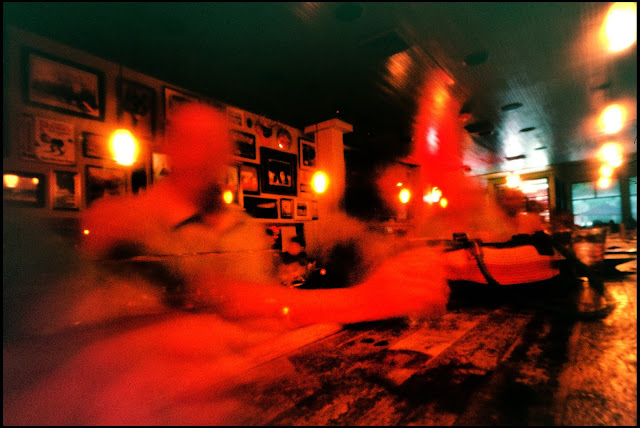Last summer when I made the New Evil Cube, I put a second pinhole above the one on the film axis. That gave me some of the capability of the rising front movement of a view camera, primarily so I could photograph buildings without them looking like they're falling over backward. I was pretty happy with the results and went a little nuts with the concept.
Not willing to leave well enough alone, I started thinking about doing a continuously variable rising pinhole since you're inevitably going to be varying distances from buildings of different heights. Another advantage of the adjustable rise is you only have to drill one pinhole.
I finally got around to it with the 24x24x24mm Manic Expression Cube. The moving shutter on that little camera is just pressed up against the front of the camera and light squeezing in between them turned out to be a problem.
I recently revisited the idea making two fronts for the Variable Cuboid, at 45mm and 60mm. With a 6x6cm format camera there's a lot more room inside to work with. I connected the moving shutter to a panel on the inside of the camera to create more of a light trap.
The overlap at the top, when the shutter is at it's lowest position, is only about a quarter inch. There was a light leak when I rode around in full sun for 50 miles with the camera on a tripod strapped to my bicycle rack. That included one incident going over a railroad track where the camera popped off and bounced down the highway. It seems pretty light tight in more normal circumstances.
Sharp eyed viewers might be wondering why only the 60mm has a hood to shade the pinhole after I made kind of a big deal about putting a hood on a 45mm camera in a recent post. The 45mm front was the first prototype and it has a couple additional layers of cardboard on the inside and the outside parts of the moving shutter, so the pinhole is recessed a bit more. Combined with the wider angle, any additional depth would have obscured part the image.
The moving part extends the entire width of the camera and the position of the pinhole is indicated by white beaded pins.
I started testing with the 60mm front mounted. The moving shutter moved a little too easily and it was difficult to open the shutter without moving it after adjusting the rise precisely. I finally overcame this by putting a couple rubber bands around the camera and over the shutter. That worked fairly well but I've since squeezed another piece of cardboard behind the moving part so that it's tighter and now it stays in place when you pull the shutter open.
A retrofitted vent in the wall of the old Chief Oshkosh Brewery. Not a bad pinhole, eh? If you zoom in to full resolution you can read that the vent is an 18" ILC Auto Shutter No. 2454.

Last year I photographed the passageway that joined the old and new Evangelical Lutheran Churches. This is the other side of that junction. It's now been sold to another congregation.
Like the Paine Art Center and the Oshkosh Public Museum, The Morgan House is another residence of an Oshkosh lumber baron that's now a museum. This one is preserved as an original Victorian home.

I switched to the 45mm front in a changing bag while sitting on the ground. I'm pretty pleased how easy it is to switch these fronts.
Morgan's factory is now a giant empty lot on the shore of the Fox River. This little house, that must have been some kind of an office, is still standing on the corner of the property.
The Granary was a flour mill for a hundred years until 1982. It's since been home to several bars and restaurants. The most recent one just closed and now it's the office of a public relations firm.
I photographed this alleyway last year on my first outing with the Variable Cuboid.
Turning around, looking down the alley toward Algoma Boulevard.
Back home, one of our volunteer oak trees with the neighbor's chain link fence newly covered with invasive, but in this case welcome, grape vines. Usually the point to using a rising front is get a higher view while keeping your verticals parallel. For this picture, I lowered the camera and raised the pinhole so the neighbor's garage wasn't visible in the scene.
After all the rain in June, we decided to build a raised garden bed. While everyone else is awash in ripe tomatoes, ours are still green.
The 60mm front has .30mm pinhole and the 45mm a .27mm, both hand-drilled.
The film is Kodak TMax 100 stand developed in Rodinal 1:100.




































